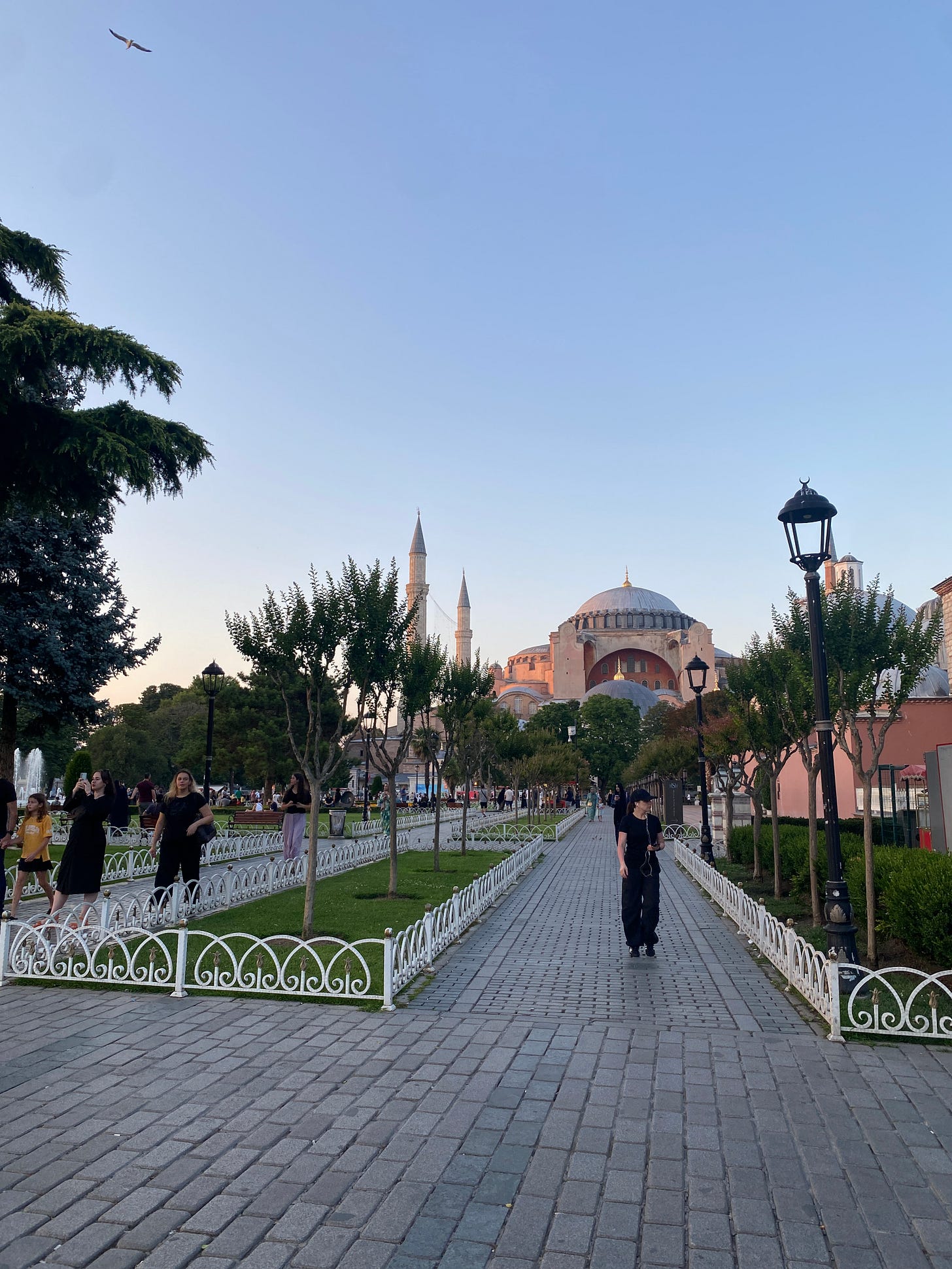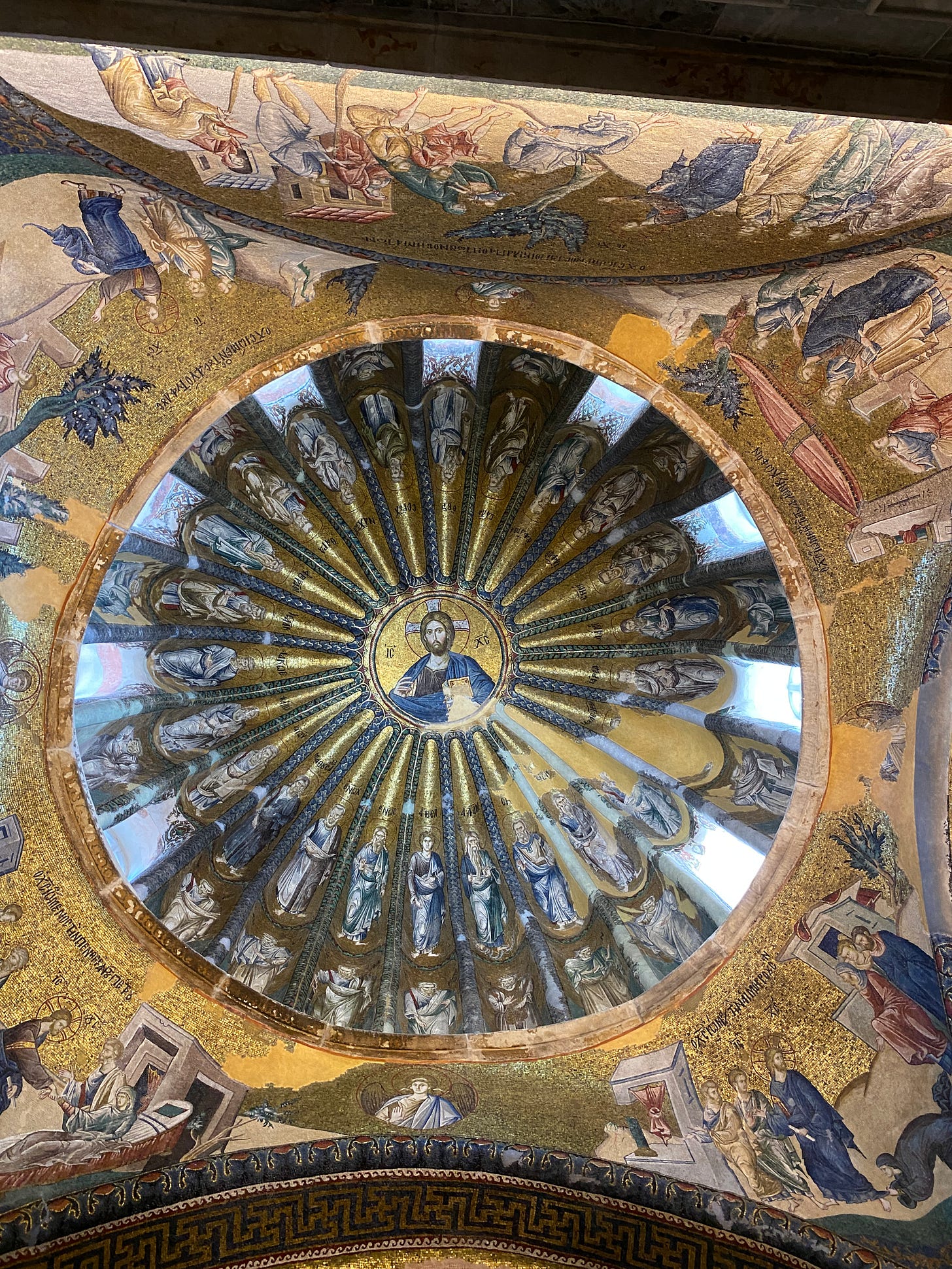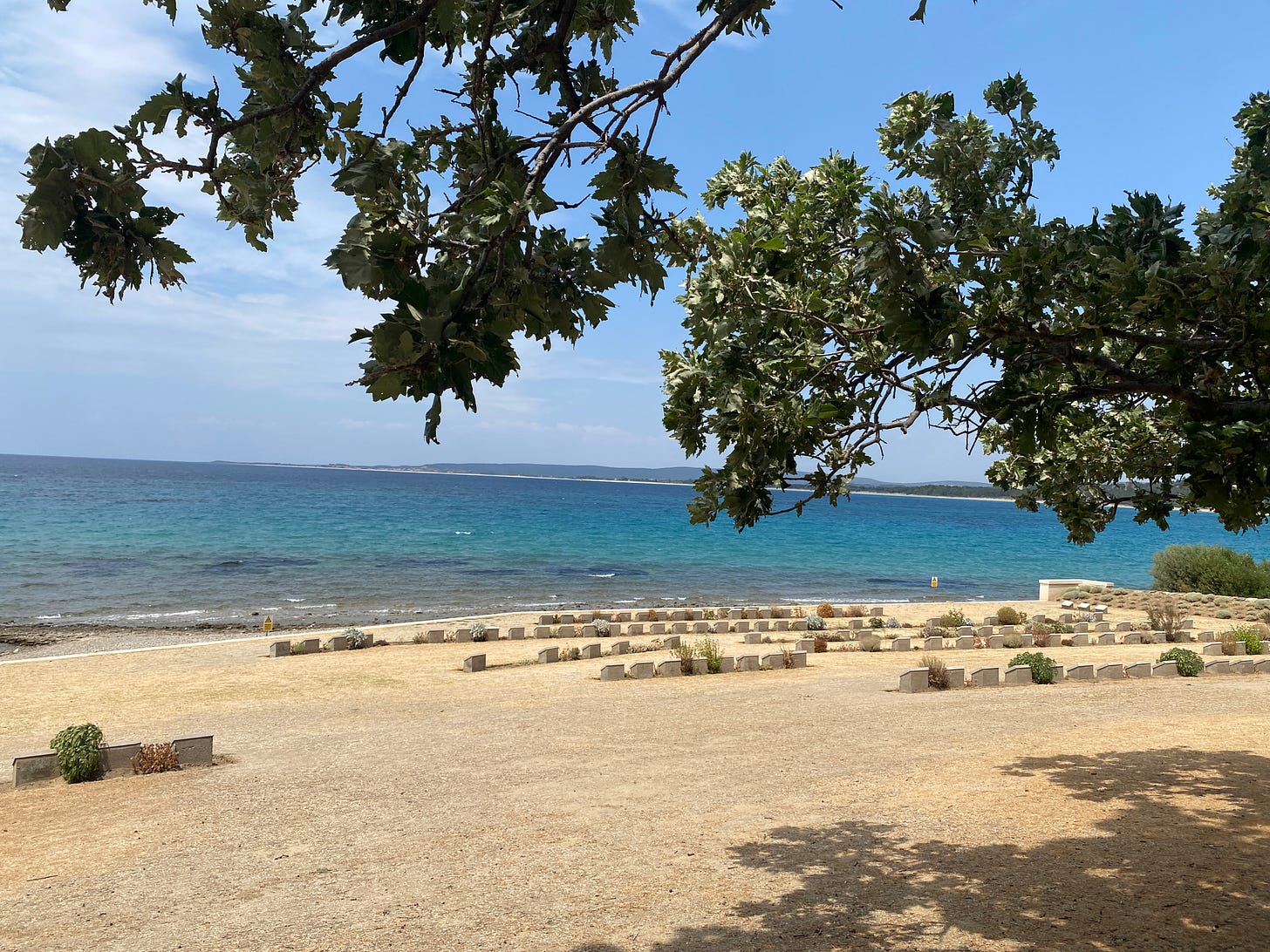Treasures of Turkey: Byzantine Art, Natural Beauty, and a Cost of Living Crisis
Turns out there's a country just as expensive as the UK...
After spending a good amount of time in Morocco (cheap) and then taking a week-long break in London (not cheap), I thought my days paying more than $8AUD for a coffee were over. With deceptively cheap flights and accommodation, I was anticipating some much-needed financial relief from the pain of the UK at my next stop in Turkey. But alas, turns out that I decided to travel there in the midst of one of the country’s worst financial crises in history. Of course.
Prices aside, I was excited to explore more of the Islamic world. Turkey has some of the most interesting historical sights in the world due to the extraordinary clashing of empires that has occurred over the ages. From Ancient Greece, Ancient Rome, the Byzantine Empire, Ottoman Empire and modern day Turkish Republic, the land has changed hands so many times it’s hard to count.
However, I had also heard that it was important to be on the lookout for scams in Turkey, particularly in the taxis.
So, when I arrived at Istanbul airport at 1am and my transfer didn’t turn up, I knew I was in for a doozy of a ride. The taxi driver I ended up with was good fun and gave me lots of food and culture tips for the centre, but he took me on a detour over one of the bridges to ‘show me the lights at night’ which cost me a pretty penny. By 2am, I’d had enough of the antics and was just ready for bed.
And taxi drivers wonder why consumers prefer Uber.
How bad could a financial crisis be for the 17th largest economy in the world?
One thing became clear as I discovered more of Turkey: the economy and industry were big topics with locals. Many people felt that the government was not doing enough to address the current financial crisis, with one local even suggesting that their most common tactic was just to deflect and say “but we have good roads!”.
To put the cost of life in Turkey into perspective, the cost of visiting the Hagia Sofia, one of the world’s oldest, largest, and grandest churches (now a mosque) was a cool €30 ($50 AUD). Bear in mind that entry used to be free (up until February this year), and that entry to the Louvre in Paris, home to some of the world’s greatest art collections and over 35,000 works on display, is just €22. If that wasn’t enough to shock, entry into Topkapi Palace (home to the old Sultans of the Ottoman Empire) cost €50+. On the more day-to-day side of things, a coffee could easily cost 150 lira (€4), when years ago it was just 10 lira. A fish sandwich before COVID-19 was 16 lira, and now the going rate is 120 lira.
Inflation is currently sitting at about 70% in Turkey, and I continued to ask the question of every guide I had: How can local people actually live with such prices?
With an average annual salary per year of just €10,000, and some prices now even exceeding those of London, the maths was not adding up. One of the most satisfying answers I got from a local was that a significant portion of Turkey is actually very, very wealthy, so not feeling the effects of the inflation as much as anticipated. To put this in perspective, the wealthiest 20% of Turkey earn 49.8% of total income. However for those other 80%, perhaps they would be in a world of pain. But I’m still not satisfied I’ve got an accurate answer.
Sightseeing Highlights of Turkey
Istanbul
I had heard mixed reviews about Istanbul, so was keen to explore and make up my own mind. The first thing I noticed was just how many mosques there were on the horizon, all created in the classical style of the Hagia Sofia. Geographically, the city looked like a mess as I arrived, split between two continents, broken up by bridges and divided by the impressive Bosphorus. As a result, I found getting around a bit overwhelming at first, until I figured out the public transport system, which was both cheap and very efficient.
I started to learn more about the incredible strategic position of Istanbul at the head of the Bosphorus and between the European and Asian continents. This has made it one of the most hotly contested cities in history. Most famously, it was capital of the Roman Empire and the Christian world in 330, best known as Constantinople until it was conquered by the Ottoman Empire in 1453.
One very interesting thing I learned about modern Turkey is the fact that it is a mostly Islamic country, however religion is not built into the constitution in the same way as other Islamic countries, like Morocco. It is extremely cosmopolitan as a result, with a mix of different views on politics, expressions of fashion, and faiths.
Mustafa Kemal Atatürk, the founding father of the Republic of Turkey, is mostly to thank for this model. I don’t think I have ever seen a political leader so venerated in a modern country before. Everywhere you went, there were statues, flags and banners emblazoned with Atatürk’s face. His modernisation efforts following World War I included the introduction of women’s rights, abolishing sharia courts, introduction of surnames, investment in the fine arts, and many important political reforms. He was also responsible for the phasing out of the Arabic alphabet and a transition towards a Latin alphabet that more accurately depicted modern Turkish pronunciation.
I was stunned by how cosmopolitan, lively, and progressive Istanbul was as a city. Everywhere you walked, you’d see a mix of different people, cultures, styles of dress, and plenty of tourists. I was pleasantly surprised by just how safe I felt compared with other cities of a similar size, such as New York and Buenos Aires.
The crown jewel of the city (besides the 86 carat diamond in Topkapi Palace) is the Hagia Sophia, now the Grand Mosque of Istanbul. Built in 537 AD, it is home to some of the most extraordinary Byzantine mosaics in the world, which have previously been covered by plaster when the building was used as a mosque between 1453 - 1935. Even today, since its reversion to a mosque in 2020, there are black curtains that hide many of the Christian mosaics that are blocking the direction of worshippers facing Mecca.
Almost as impressive is the 4th century Kariye Mosque (Chora Church), which sits in the Balat neighbourhood of Istanbul, just outside the original old city walls. With free entry (for now), it is well worth a look as the mosaics are even better preserved than those of the Hagia Sophia, and though small, the concentration of mosaics and frescos are quite impressive.
I also visited the Topkapi Palace, which was extremely extravagant, a mark of the true wealth and power of the Sultans of the Ottoman Empire. We learned about very concerning practices such as fratricide, the murder of state officials, and harems, which painted a disturbing picture of how ruthless this era was.
Finally, I thoroughly enjoyed taking a cruise of the Bosphorus, which gave a great view of the sheer scale of the city and different styles of living. Taking a ferry over to the trendy Asian side of the city felt like a huge novelty, and eating a fish sandwich by the water was also an iconic experience (though not very local I am led to believe).
Gallipoli
As an Australian, I felt that a visit to Gallipoli was absolutely essential to my stay in Turkey. The Gallipoli campaign is probably one of the most talked about events in Australian military history, and I was keen to visit and pay my respects, as well as visualise what had taken place. I was not aware that the Battle of Gallipoli was quite a significant event for Turkey too, as one of Atatürk’s key military victories before rising to power as the first President of the Republic of Turkey after the war.
It was really interesting to get the context on why the Allies sent Aussie and New Zealander troops there at all. The Dardanelles has been one of the most important passages to control in history (see: Troy), and the Ottoman Empire had stationed mines deep under the sea, doubly protected by guns on each side of the shore. In order for the British troops to access the passage by sea, they needed to disarm the Ottoman guns, and the best way to do that seemed to be to land on the Gallipoli peninsula and attack on foot.
The beach landings were miscalculated — while ANZAC troops were supposed to land on Brighton Beach, a flat area that would have led to a somewhat easy passage on foot, they landed at ANZAC Cove, where there was much more steep and bumpy terrain. This slowed the troops down significantly, and gave the Turkish army time to bring reinforcements, overwhelming the ANZACs. While the British had sent reinforcements that could have helped keep the Turkish army at bay, a miscommunication led to them taking a day off on the beach before advancing, meaning that while they were bathing in the turquoise waters of Cape Helles beach, a bloodbath was taking place inland.
We learned about many, many silly mistakes and military failures, including a miscommunication when the NZ troops managed to gain control of the target (Achi Baba, a tall hill that gave a clear view of the shoreline where the guns were located). This miscommunication led to other NZ troops firing on themselves.
After visiting the D Day Landing Beaches of Normandy earlier in the year, I was quite taken aback by how understated the Gallipoli memorials were, with very faded signs, some typos on memorial stones and very sparse gravestones, despite over 130,000 soldiers (from all armies) losing their lives in the campaign. This shocked me, particularly seeing how much love the Australian government had put into the Hellfire Pass information centre in Thailand, by way of contrast. But overall, it was an interesting and informative visit — well worth the day trip from Istanbul.
Cappadocia
We’ve all seen the balloon photos on someone’s feed, and it’s been in the back of my mind to visit Cappadocia one day in my life for the incredible views. So this trip, I went for it.
I have probably never been somewhere that is so specifically designed just for tourists before. Apparently, when the balloons started becoming popular in the 1990s, Cappadocia all of a sudden took off as a destination. This somewhat surprised me, because the open air museums are quite impressive in their own right!
The region is known for the beautiful ‘fairy chimney’ style houses cut into the unique rock formations. It is also home to some of the most unique monasteries I’ve ever seen — safe places that Byzantines used to hide Christian communities in to escape persecution.
I particularly enjoyed the stunning frescos of the Dark Church in the Gorëme Open Air Museum, visiting the Underground City in Derinkuyu, which was over 7 floors deep into the ground, and horse riding through Love Valley at sunset.
Finally, I will say that the balloons were entirely worth it. I managed to find a last-minute balloon ride for 50% off, and we set out at sunrise. The landscape looks completely different from the air, like some kind of magical video game land. It was well worth it to get up for sunrise on the other morning I was there too, to watch the balloons go up from a different angle. Of course, the locals have started charging entry to view the balloons from the natural viewing point, which I found absolutely ridiculous.
Izmir
My final stop in Turkey was Izmir, a port town popular with cruise ships, which is quite close to Ephesus. Ephesus is one of the best preserved Ancient Greek towns in Turkey, and an absolutely stunning historical site.
Besides this… Izmir was not at all my favourite stop. These are harsh words, and usually I like to give places the benefit of the doubt. But walking the streets in the heat was not a pleasant experience — there was rubbish everywhere and debris leftover from earthquake damage. There didn’t seem to be many main attractions in the city, and there were parts where I felt a little unsafe. I was also subject to another taxi scam, which didn’t leave a good impression.
I did a tour to visit Ephesus and also the suspected former house of the Virgin Mary, which was located nearby. Ephesus was a brilliant way to walk in the footsteps of the Ancient Greeks and Romans. While it used to be a port town, the sea has since receded and it sits inland. It has one of the best preserved ancient libraries in the world, and the largest theatre in Anatolia.
For my final afternoon, I took a tour to Çesme and Alaçati, two small towns near the coast of Izmir. One of my highlights to my stay in Turkey was that final swim in the Aegean Sea at sunset. The turquoise water and beautiful surroundings were a brilliant way to cap it all off!
Reads on the Road
Prophet Song by Paul Lynch.
This month I read Paul Lynch’s Booker Prize award-winning Prophet Song. The novel is a dystopian vision of Ireland in a society where democracy has slowly disintegrated. It is beautifully written, with a stream of consciousness style at times, and descriptions that bleed nature into the harrowing events. I wouldn’t exactly describe this as a fun read — it was slow at times and heavy content, but very powerfully written with a strong message about protecting democratic values at all costs.
My final piece of advice? If you’re thinking about visiting Turkey… just wait a couple of years. Rumour has it, it’s going to get cheaper again. (But honestly, who knows!) If I go back to Turkey, next on my list is to explore the beaches near Antalya, and possibly the north, bordering the Black Sea.
That’s it for this month! I have just had a very rich couple of weeks exploring Germany and Poland, which will likely be the subject of my next newsletter. For now, I am stationed in The Dolomites in Italy, hiking and soaking up the sun! Ciao!










